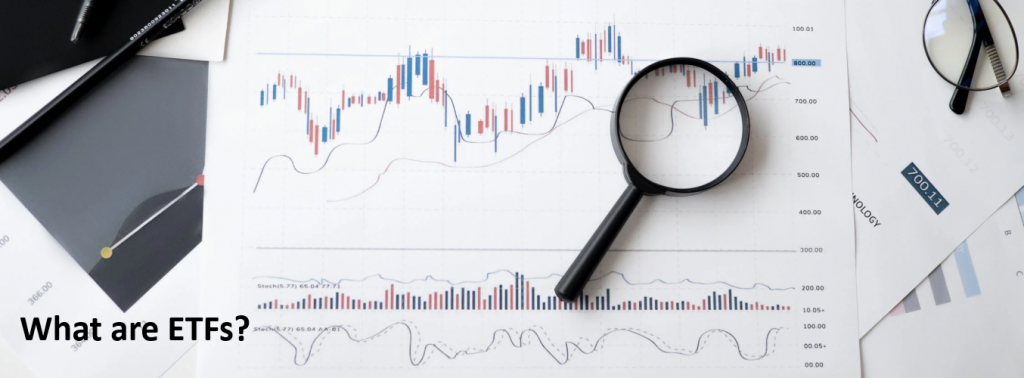Are you looking for ease of stock trading, but with the same diversification of a mutual fund? Exchange-traded funds (ETFs) allow you to combine the best of both.
In this article, we will answer all the important questions about ETFs. We go through how they work, the different types of ETFs, and the benefits and drawbacks that you should know about.
What Is an ETF?
An ETF is a basket of several securities that you buy or sell on a stock exchange. This type of fund tracks anything from the price of an individual commodity to a large collection of securities. ETFs usually contain several types of investments. These include stocks, bonds, commodities, or a mixture of investment types.
ETFs offer cheaper broker commissions than buying individual stocks. They are generally more cost-effective and more liquid than other investment vehicles such as mutual funds. Because ETFs consist of many different types of assets, they are a popular way for traders to diversify their portfolios.
>> Looking for a broker? Check out our guides:
How do they work?
An ETF is a type of fund that traders buy and sell on an exchange. ETFs allow you to trade a collection of assets instead of individually buying and selling each component. Trades occur throughout the trading day via a brokerage service, like stock trading. They often have lower commission fees than other types of funds. Depending on the type of ETF, there are varying levels of financial risk.
ETFs are created by fund providers who own the underlying assets in the fund. They design the fund to track their performances and then sell shares in the fund to investors. Shareholders will own a portion of the ETF, but they won't own the underlying assets in the fund themselves.
The price of an ETF’s shares will change throughout the trading day as traders buy and sell shares on the market. Some ETFs track an index of stocks, which creates a broad portfolio. Others only target specific industries.
The SPDR S&P 500 fund is the oldest and most well-known ETF that tracks the S&P 500 Index. Another well-known fund is the Invesco QQQ which indexes leading Nasdaq stocks. This usually contains stocks in the tech industry.
ETFs are a great way to gain exposure to any market or industry sector in the world. They allow you to invest your assets in a straightforward way while giving you enough flexibility to be any kind of investor that you want to be.
Types
Here are the most common types of ETFs available to investors.
- Bond ETFs are designed to give you exposure to every type of bond available. These include government bonds, corporate bonds, and state or municipal bonds.
- Sector or industry ETFs track a certain industry. For example, the tech industry, banking, or the oil sector.
- Market ETFs are set up to track a particular index such as the S&P 500.
- Currency ETFs are funds that invest in foreign currencies such as USD or EUR.
- Commodity ETFs are designed to track the price of a commodity invested in commodities. This includes commodities such as gold or oil.
- Inverse ETFs involve shorting stocks to make a profit from decreasing values in stock.
Advantages of ETFs
Here are the most common reasons why ETFs are such a popular choice for traders.
Low trading fees: ETFs have lower average costs than trading individual stocks. Traders only need to execute one buying transaction and one selling transaction. This leads to fewer broker commissions. Some brokers even offer commission-free trades on certain ETFs which reduces costs even further.
Easy to trade: Traders buy and sell ETFs at any time of the day, unlike mutual funds that only trade at the end of the day.
Diversification: ETFs give investors access to many stocks across industries and a variety of order types. This is a great way to diversify your portfolio. Risk management through diversification is a popular trading strategy.
Transparency: ETFs are often index-based. To follow the rules set out by financial authorities, index-based ETFs have to publish their daily holdings.
Tax efficiency: ETFs tend to generate lower levels of capital gain compared to other funds.
Disadvantages of ETFs
There are several drawbacks to be aware of when it comes to ETFs.
Higher active trading costs: There are a few ETFs that don't passively track an index. There are higher fees for actively managed ETFs that involve frequent trading in small amounts.
Illiquidity: Some thinly-traded ETFs have wide spreads. These have a lack of liquidity that hinders transactions. This means you might be stuck buying at a high spread price and selling at a low spread price.
Settlement dates: ETF trades are not settled for 2 days following a transaction. This means that your funds as the seller won't be available to reinvest for 2 days.
Tracking errors: ETFs generally track their underlying indexes well, but there are occasional technical issues. These sometimes create potential discrepancies.
Regulation of ETFs
With the increasing popularity of ETFs trading and the total assets under management at an all-time high, ETFs have gained an extra level of scrutiny from global regulators. In the US, most ETFs are set up as open-ended funds. These have to follow the Investment Company Act of 1940. All shares that they offer must be registered under the Securities Act of 1933.
ETFs are subject to a capital gains tax when you make any profit on a trade. Make sure you check for the latest tax regulations with your broker. After the annual exclusion allowance is taken into consideration, a percentage of your annual capital gain will be added to your taxable income for the year.
Conclusion
An ETF is a basket of securities that investors buy and sell on an exchange, like the stock exchange. ETF share prices fluctuate throughout the day. ETFs contain a variety of investment types. These include stocks, bonds, and commodities.
With many advantages such as fewer broker commissions and low expense ratios, ETFs are a popular investment vehicle for many investors.
Article Sources:
- SEC.gov. “SEC.gov | Laws and Rules, https://www.sec.gov/investment/laws-and-rules.” Accessed June 16, 2021.
- Wikipedia. “Exchange-traded fund – Wikipedia, https://en.wikipedia.org/wiki/Exchange-traded_fund.” Accessed June 16, 2021.




